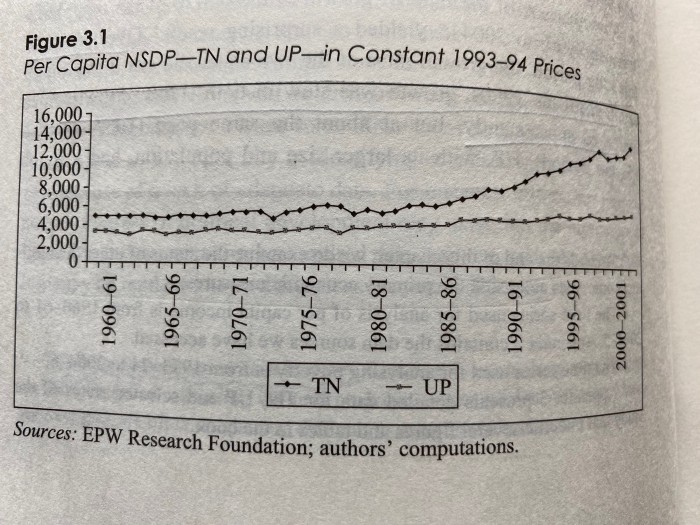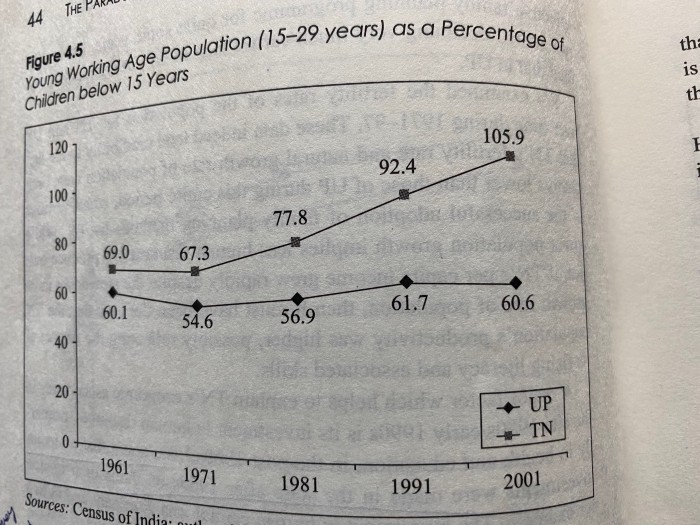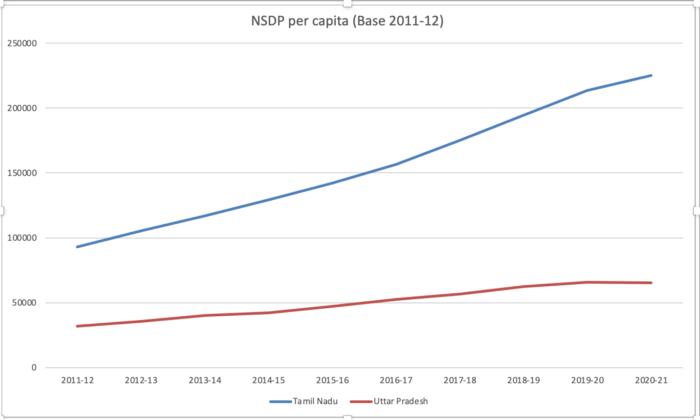Why is Uttar Pradesh such an economic laggard?featured
The economy of Uttar Pradesh (UP) has grown much slower than that of Tamil Nadu (TN) for more than three decades. This was not always so. The two states grew similarly in the first few decades after independence. What it more, it is not easy to figure out why. These are the messages that I took from the book The Paradox of India’s North-South Divide: Lessons from the States and Regions. [1]
The book begins with the comparison of the per capita Net State Domestic Product (NSDP) of UP and TN. NSDP is a measure of economic activity and dividing it by the population makes it possible to make comparisons across states with very different populations.

As can be seen, the per person economic activity in TN was always higher than in UP. However, it was only in middle to late 1980s that the economic activity in the southern state started growing much faster than the Northern one. National policies changed significantly starting in late 80s and TN was able to take advantage of those but UP couldn’t. Why?
The authors have looked at human resource capabilities, urbanization, basic infrastructure, efficiency of resource utilization, governance including political stability and law and order and what they called demand factor arising out of social mobilization as factors to explain the performance between UP and TN. However, to me some of the explanations are less enlightening or convincing compared to others. [2] Let us first look at the not so convincing ones and begin with the literacy ratio.
The authors point out that the literacy ratio in TN has always been higher than UP and that may have contributed to TN’s breakout performance. But the literacy in both states has been increasing and the rate in UP in 2000–01 was higher than it was in TN in 1980–81. So, if literacy was the driving factor, then UP should have started closing the gap in the recent years! It hasn’t.
Take another example, technical education. The authors first wondered if the number of graduates was an explanatory factor. But they found that UP had a higher proportion of graduates than TN! So, the authors speculated if it mattered if the graduates were getting technical degrees rather than basic degrees in arts, science and commerce. They found that the proportion of students enrolled in technical courses was indeed higher in TN. But to me it is not clear which way the causality runs. Are more technical graduates in TN causing better economic performance? Or is the better economic performance creating a higher demand for graduates of technical courses?
Another factor that looked promising initially was political stability. The authors have used tenure of the Chief Minister as a proxy. They say that between 1967 and 1985, UP saw 18 CMs and periods of President’s rule. In contrast the CM changed only three times in TN. The tenure of CMs in UP increased after that and in TN it reduced slightly. However, the gap between them was still large. Between 1984–85 and 2008–09, the average tenure of CM in TN was 1,058 days and was only 390 days in UP. The book was published in 2015 and the much of the analysis is for periods before that. Have things changed since?
Indeed, they have. UP has seen a remarkable stability in tenure of CMs in the last fifteen years. The last three CMs — Ms. Mayawati, Mr. Akhilesh Yadav and Yogi Adityanath — all completed their full term. The average tenure for CMs for last 15 years is more than 1500 days! But did this make a difference? No, as I will show later in this post.
One of the factors that had some explanatory power was demographics. Here is another interesting chart from the book.

As we can see, in 1980s the ratio of young working age population and children in TN started increasing as the number of children per woman reduced a few years before that. As a consequence, the state had more and more working age adults as compared to children and by the end of comparison period, young working aged folk was more than children. Many of these working age folk would have sought employment and would have got it. Even if the employment was not very productive, the state NSDP per person would have increased faster than it did in UP. This is demographic dividend. Of all the factors discussed by the authors, I found this most convincing.
Two other interesting factors examined by the authors were the Law-and-Order situation and what the authors call demand factor. Based on discussions, the authors concluded that a relatively peaceful law and order environment, presence of good work culture, promise of good infrastructure and proximity to ports led to industry locating in TN. I have had discussions with business leaders across the country, and this seems right to me too. However, it begs the question — why could TN fix its law and order and work culture and UP couldn’t?
Let us now look at the demand factor. The authors say that a more demanding populace makes government’s policies and scheme more effective. A critical part of public becoming demanding is that even the poorest, who are usually from the deprived castes, become aware of their rights and fight for them. This sounds right to me but it again begs the question why was population in UP unable to do this.
As I mentioned, the last three CMs of UP have completed their full terms. Two of them, Ms. Maywati and Mr. Yadav, are not from upper castes. Ms. Maywati was born in a dalit family and Mr. Yadav’s caste is included in Other Backward Castes. They completed their full terms. Yet, they were not able to change the demand factor from the weaker castes in the state? Similarly, the current CM Yogi Adityanath has talked a lot about improving the Law-and-Order situation in the state. But that has not reflected in the state NSDP per person yet. As can be seen below, TN NSDP per person keeps galloping ahead.

Maybe businesses invest in state only after they see a long period of relatively peace. Maybe, it takes many years of demand from public for the state to become more efficient. Maybe all of this will come together soon. The state will become peaceful and more equitable. The fertility is also dropping in the state and soon it will also be beneficiary of the demographic dividend. Maybe all of this will happen together and soon. Hopefully.
Update: From the comments that I have received here on the blog and on social media, two themes emerge.
1. Is presence of a seaport important? Generally speaking, coastal states in India have done better economically than hinterland states although there are exceptions. Being close to a port may be very important for manufacturing, especially low-cost manufacturing that employs a lot of people. As a comment on the blog points out, this is believed to be a crucial factor for economic development of nations.
2. Law and Order: Almost everyone believes that the law-and-order situation in UP and North in general is way worse than it is in Southern states and that discourages business investment. As I mentioned in my post, this seems right to me. It is difficult however to measure law and order objectively as most measures can be and are gamed. The book I referred to has three measures for evaluating this factor. Police firing per million population, proportion of civil to total police (consisting of both civil and armed police) and pending cases in court. On all three measures TN has done much better than UP. While, I share the belief in importance of law and order and the perception that UP has been much worse on it than most off the country, I am not very happy with the measures but I do not have good alternatives.
Relatedly, many commentators have claimed that the situation has improved under Yogi Adityanath. As I have pointed out, the NSDP / capita of UP has seen no consequent improvement. Supporters of the current CM argue that the law and order needs to be better for a long period of time before businesses become confident about making investments. I am sympathetic to this argument. However, I hope that everyone agrees that ifBJP comes back to power and if by the end of their second term, the NSDP / capita has not started catching up with the South then BJP also would have failed UP economically.
[1] The book talks of economic divergence between Northern and Southern states and TN and UP are used as foundational case studies.
[2] The authors are fairly humble in their discussion of the factors that may be contributing to the economic divergence. I commend them for their tone.
Author –
Yogesh Upadhyaya
(Yogesh Upadhyaya is one of the founders of AskHow India. Blogs are personal views.)
You can follow AskHow India (@AskHowIndia) or me (@YogeshUpadh) on twitter or me on LinkedIn or Medium. DM me if you wish me to put you on WhatsApp distribution list.



